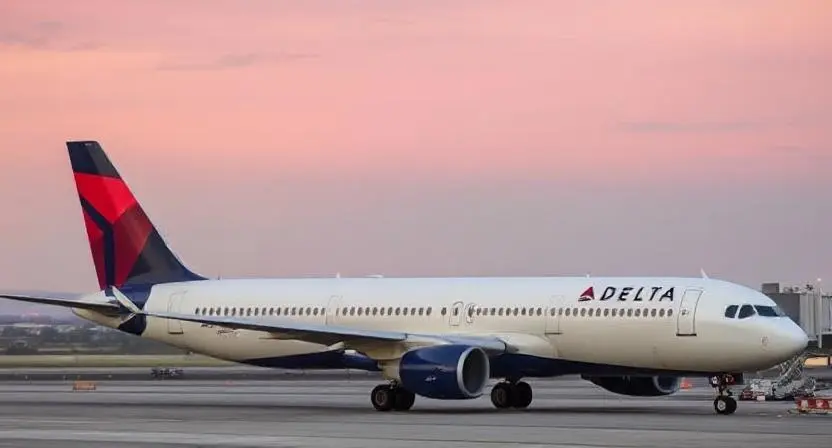We are discussing delta flight dl275 diverted lax today. Due to unforeseen mid-air problems, Delta Flight DL275 had to be diverted immediately to Los Angeles Airport.
Introduction
An unplanned mid-flight diversion to Los Angeles International Airport (LAX) occurred on July 17, 2025, on delta flight dl275 diverted lax, a regularly scheduled international route from Incheon International Airport (ICN), Seoul, South Korea to Hartsfield-Jackson Atlanta International Airport (ATL), USA. Passenger welfare and aircraft integrity were given top priority in the event, which took place over the Pacific Ocean and featured normal aviation safety measures.
At the time of the diversion, the delta flight dl275 diverted lax was transporting about 275 passengers and crew members. The flight crew reportedly decided to divert after a passenger’s health deteriorated during an onboard medical emergency, and they worked with ground control to find the closest airport that could handle a wide-body aircraft.
The reason behind the diversion of Delta Flight DL275 Diverted Lax to Los Angeles (LAX)
A significant medical emergency involving a passenger who needed immediate treatment that was not available onboard was the main justification given for the detour. In such cases, Delta’s internal safety procedures and aviation rules require prompt action. Because of its accessibility, medical facilities, and standing as a major international hub with capabilities capable of managing complicated situations and large international flights, LAX was determined to be the best option for diversion.
According to reports from passengers, the cabin staff responded quickly and competently, offering first aid help right away and communicating with ground-based medical personnel via satellite communication equipment. After consulting with air traffic control, medical experts, and Delta’s operations center, pilots decided that landing at LAX was best for the impacted passenger and the safety of the entire flight.
Events in Timeline: Departure to Diversion
- Departure: On time, delta flight dl275 diverted lax left Incheon International Airport (ICN) for Atlanta (ATL).
- Mid-journey Emergency: Crew members were informed of a passenger’s medical situation about six hours into the journey.
- Diversion Decision: After consulting with air traffic control and Delta’s medical advisers, the flight crew decided a diversion was required.
- Landing at LAX: The plane touched down without any problems at Los Angeles International Airport (LAX). When emergency medical workers arrived, they were ready to take the impacted passenger to a nearby hospital.
- Post-Diversion: Following the safe transfer of the passenger, the plane was refueled and subjected to standard safety checks before continuing on to Atlanta.
Experience of Passengers While the Diversion Was In Progress
Social media posts and passenger statements indicate that the environment on board stayed composed and orderly during the incident. Travelers were kept updated on the situation and anticipated delays by the cabin crew’s frequent and clear communication. Travelers commended Delta employees’ professionalism and compassion, pointing out that medical attention was discreetly and quickly provided.
During the unplanned stopover, passengers received updates and refreshments. Through their app and customer service representatives stationed at delta flight dl275 diverted lax made sure that passengers with close connections in Atlanta were rebooked in advance.
Effect on the Flight Timetable and Further Activities at Delta Flight DL275 Diverted Lax
The overall arrival time in Atlanta was delayed by roughly three to four hours as a result of the diversion. In accordance with U.S. DOT requirements and Delta’s internal standards, Delta Airlines has procedures in place to effectively handle such circumstances, such as providing meal coupons, making accommodations for missing connections as needed, and providing compensation.
To make sure the aircraft was still airworthy after the diversion, Delta’s maintenance crew at delta flight dl275 diverted lax performed a comprehensive inspection. After being cleared, the aircraft continued its transcontinental voyage and safely touched down in Atlanta later that night.
Safety Procedures Involved in the Choice
When deciding whether a flight diversion is required, airlines—including Delta—are subject to stringent international aviation regulations. These rules give priority to:
- Safety and Health of Passengers
- Safety and Airworthiness of Aircraft
- Accessible Medical Facilities and Appropriate Airports
- Operational factors including weather and air traffic
In this case, LAX was the most sensible and secure option based on all the criteria.
Delta Flight DL275 Diverted Lax Reaction and Safety Commitment
In a formal statement, Delta Airlines reaffirmed its dedication to the safety of its passengers and the welfare of everyone on board. The airline commended its flight and cabin personnel for their professionalism under duress and underlined the significance of quick, prompt action in medical crises.
Delta also emphasized its long-standing collaborations with international medical advisory services, which offer crews coping with medical emergencies in the air round-the-clock advice.
How Often Do Medical Diversions Occur? Delta Flight DL275 Diverted Lax
Although they are not uncommon, medical diversions are rather uncommon. The likelihood is higher on long-haul international flights because of the length of the trip and the passengers’ demographics, which include older passengers and those with underlying medical concerns. Less than one medical diversion per 20,000 flights was recorded by US airlines in 2024.
The following are important variables affecting medical diversions:
- The severity of the illness
- Onboard Medical Supply Availability
- The distance to the closest appropriate airport
- Weather and Flight Path
Here, a prompt and efficient response was guaranteed by the crew’s adherence to established medical diversion guidelines.
Things Travelers Need to Know About Emergencies While in Flight
Travelers who are worried about medical emergencies should be aware of:
- First aid, CPR, and the use of onboard medical kits, which include AEDs (Automated External Defibrillators), are all areas in which flight crews receive extensive training.
- Airlines collaborate with medical professionals on the ground to provide real-time decision support.
- Rarely can diversions occur, and they are always done to guarantee the best result.
- Travelers with known medical conditions should speak with their physician and let the airline know in advance if special accommodations are needed.
FAQs
- What caused Delta Flight DL275 to change its route to LAX?
Although there aren’t many official reports, it’s probably because of a technical problem that needs to be fixed right away.
- Are diversions compensated for by airlines?
Indeed, depending on the extent of the interruption, airlines such as Delta frequently provide rebooking, coupons, or lodging.
- Do planes frequently divert to other airports?
Although it’s not common knowledge, diversions occur frequently worldwide when safety necessitates it.
- How are unplanned flight landings handled at LAX?
To effectively manage diversions, LAX has seasoned staff that can promptly collaborate with airlines.
- When a flight diverts, should passengers be concerned?
Absolutely not. Usually, it’s a preventative measure to make sure that everyone’s safety comes first.
Conclusion
A stark reminder of the strength of aviation safety procedures and the commitment of airline employees to saving lives in the air is provided by the diversion of delta flight dl275 diverted lax. Even though such incidents could be inconvenient, everyone’s health and safety are the top priorities.
Delta’s response to this crisis is a prime example of industry best practices and demonstrates the importance of significant carrier investments in partnerships, training, and backup plans.
















Leave a comment